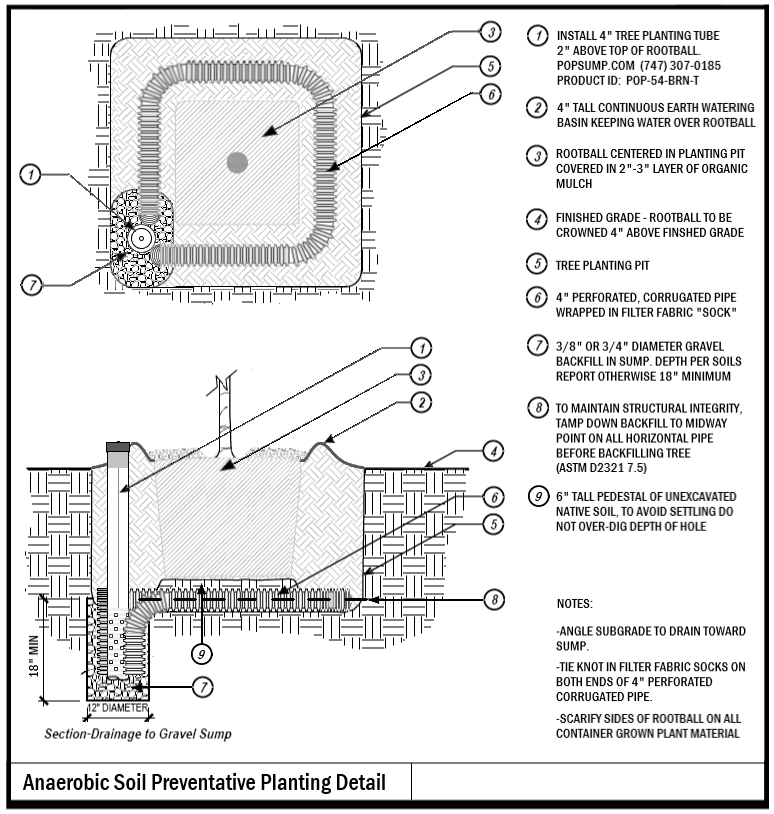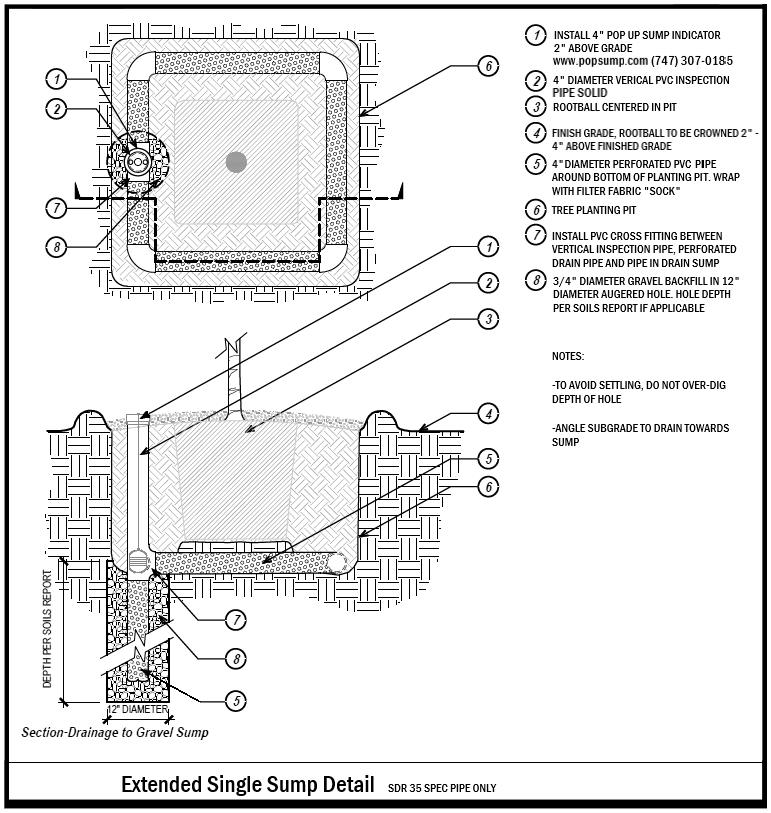Planting Details:
Our details take a different approach than anything currently availible - with a focus on correcting water issues through PROACTIVE measures all while mitigating anaerobic soil conditions. Currently all major planting details are REACTIVE to overwatering issues with a focus almost exlusively focus on drainage, most require more expensive materials (SDR pipe), much more labor and machinery (auger attachments, etc).
These details have been developed by compiling nearly 100 planting details over the past 10+ years from esteemed landscape architecture firms and extensively testing them in the field, taking what works and removing what doesnt. What we have left is distilled down and demonstrates the leading edge of efficiency, efficacy and value currently found in tree/palm planting industry.
-Percolation Test is recomended after planting pit excavation.
-To maintain structural integrity & prevent deflection in horizontal pipe, tamp down backfill in “Haunch Zone” to midway point. (Photo)
-All Specs are free to use, replicate and add watermarks/company info.
Scroll through our interactive animated detail:







Should I use Corrugated or SDR 35? Pros and Cons comparison:

Planting Details:

︎︎︎ Anaerobic Soil Preventative Planting Detail 84” - 144” Box (High Resoloution Download)
︎︎︎ Anaerobic Soil Preventative Planting Detail 84” - 144” Box w/amendment blend (High Resoloution Download)
Pros:
- Great representation of standing water under plant material
- Allows for lateral removal excess of water to be evacuated from rootzone in bigger trees
- Quick & simple Installation, less cuts, less time
- No fittings, connections, glue/primer required
- Effective
Cons:
- More expensive (still cheap compared to traditional SDR details).
- Plant material can be difficult to rotate/adjust once set in hole because of corrugated pipe
- Can be hard to plant in tight spots
- Corrugated Pipe can be hard to find
- Slightly wider sump needed
- Extra care must be taken not to support Corrugated Pipe to avoid crushing
- Transplant trees over 144” box may need internal “Grid” systems, contact “contact@popsump.com” for additional information.
Good for:
- Medium to Larger box trees and palms 72” +
- Higher clay soils
Materials Required:
Pop Up Sump Indicator Tree Planting Tube Product ID: POP-54-BRN-T (x1)ADS Perforated, Corrugated Pipe in Filter Fabric “Sock” Product ID:04730100BS (Quantity rootball size dependant)
3/8” or 3/4” Gravel (Quantity sump size dependant)
Organic Mulch (Optional)

︎︎︎ Anaerobic Soil Preventative Planting Detail 48” - 72” Box (High Resoloution Download)
Pros:
Cons:
Good for:
Materials Required:Pop Up Sump Indicator Tree Planting Tube Product ID: POP-54-BRN-T (x1)
3/8” or 3/4” Gravel (Quantity trench size dependant)
Organic Mulch (Optional)
- Allows plant material to be rotated easily, unlike above plant detail
- Easier installation than above planting detail
- Great for planting in tighter spaces, adjacent to hardscapes,etc.
- Very cheap and effective
Cons:
- Can struggle evacuating water on larger trees (108”+) especailly in clay soils
- When pumping out water (if needed), it can take a little while longer for water to seep and collect on the sump access tube side
Good for:
-
Most trees
Materials Required:
3/8” or 3/4” Gravel (Quantity trench size dependant)
Organic Mulch (Optional)

︎︎︎ Anaerobic Soil Preventative Planting Detail - Large Palm
Pros:
- Palm version of “Anaerobic Soil Preventative Planting Detail 72” - 144”
- Has palm specific detail
Cons:
-
Take care not to compress or deform tube when setting palm
Good for:
- Best for larger palms like Phoenix canariensis, Jubea chilensis, Washingtonia filifera, etc
Materials Required:
Pop Up Sump Indicator Tree Planting Tube Product ID: POP-54-BRN-T (x1)ADS Perforated, Corrugated Pipe in Filter Fabric “Sock” Product ID:04730100BS (Quantity rootball size dependant)
3/8” or 3/4” Gravel (Quantity sump size dependant)
Washed Concrete Sand (Quantity rootball/plant pit size dependant)
Organic Mulch (Optional)

︎︎︎Anaerobic Soil Preventative Planting Detail - Small Palm
Pros:
- Palm version of “Anaerobic Soil Preventative Planting Detail 36” - 60”
- Has palm specific detail
Cons:
- Take care not to compress or deform tube when setting palm
Good for:
- Smaller palms like Phoenix dacylifera, Washingtonia robusta, Queen palms, etc
Materials Required:
Pop Up Sump Indicator Tree Planting Tube Product ID: POP-54-BRN-T (x1)3/8” or 3/4” Gravel (Quantity sump size dependant)
Washed Concrete Sand (Quantity rootball/plant pit size dependant)
Organic Mulch (Optional)

︎︎︎ Olive Planting Detail (High Resolution Download)
︎︎︎ CAD Download (.DWG File)
Pros:
- Specifically developed with Olive suppliers, taylored to Specimen Olive Tree needs.
- Has cold weather specific options
Cons:
n/a
Legacy Details (these do not recieve updates)

︎︎︎ Extended Single Sump Drainage Detail (Hi Resolution Download)
︎︎︎ Extended Single Sump Materials Checklist (Excel Download)
Pros:
- Lots of space in sump for gravitational water to migrate (second only to French Drain)
- Great choice for larger trees
- SDR 35 has more resistance to point load than ADS Corrugated
Cons:
- Time consuming installation
- Deeper extended sumps may require auger attachement on excavator
- More expensive
- More bulk materials required
Good for:
- High value, larger box trees and palms
- Situations where standing water is a verified concern
- Trees species that do not tolerate standing water

︎︎︎ Tree Near Slope Planting Detail
︎︎︎ Tree Near Slope Materials Checklist (Excel Download)
Pros:
- Best case planting scenario planting detail
- Almost never has water drainage problems (clogged or crushed pipe the exception)
- Can be tied into existing gravity drain lines if lines are deep enough
Cons:
- Nearby slope at least depth of rootball is required to daylight horizontal pipe
- More time consuming installation
- More expensive
- Trenching equipment may be required for longer runs
Good for:
- All trees, this is the best planting detail to alleviate standing water

︎︎︎ “U” Drainage Detail
︎︎︎ “U” Drainage Detail (20% Organic Amendment)
︎︎︎ “U” Drainage Detail Materials Checklist (Excel Download)
Pros:
- Good comprimise of pricing and efficacy.
- Quicker installation than “Square”.
- Good representation of standing water under plant material.
- Can use a “T” fitting in place of “elbow” and create a extended sump.
Cons:
- Edges of rootball have potential for standing water, especailly on larger trees.
Good for:
- 48” - 120” Box Trees.
General FAQ
Why dont you put gravel under the tree?
Short answer, “perched water table” (photo). Most rootballs are fine aggregate, gravel is course, perched water table will hold moisture and will not release into gravel.
Why dont you have filter fabric under the rootball?
We work with tree transplanting companies, we have seen, and they have reported that the filter fabric clogs very quickly, furthermore when you have an extrememly fine sedement imbedded into filter fabric that is over gravel it GREATLY exhaserbates the “Perched water table” (photo) effect. What we’ve found through acrylic sedement tube tests is that sand or sedement will migrate to a certain point into the gravel then stop, not fully mixing into the gravel below. There is a USPGA article that examines the effect of particle size on water migration, the gist is that when you have a fine aggregate over a course aggregate (specifically 6mm difference in size or greater) the perched water table effect will hold water (particularly in the lower part of the rootball) until the rootball reaches field capacity. We do not want the rootball to hold this water.
Wont water just evaporate out of the sumps eventually? Thats why they have those grate tops.
No, we have had an ongoing experiment to assess the evaporation rate, one day ill share but short answer is “No”. In fact we found MORE water present in the sumps 4 months later (without any rain). It doesnt work, water doesnt evaporate. In fact, what we’ve seen is that if these grate tops are set low, even a little below finished grade then water (irrigation, rain, etc) freely flows down them and actually fills the sumps creating more problems.
But it allows air flow down low into the sumps?
Air flow is minimal, admittely im not aware of any studies or literature on this topic. However where you have the combination or air and moisture you will encourange root growth. If your goal is to encourage root growth in these areas you might achieve it for a certain period of time. But the point of these planting details is to mitigate excess water, not to encourage root growth in the sump.
Will it work as an “Airtube”?
The primary feature of sump access tubes is to make the user aware of and alieviate excess water, as a secondary function i have heard the argument that they can act as an “airtube” to allow trapped gasses a way to escape that may have been trapped while planting. While i have never seen a tree die from this personally, anecdotally i have heard stories with questionable credibility. Our product does allow for air/gasses to escape if this is of particular conern to you. In short we’re not 100% sure but if you have any literature on this, please email us as we would love to further research the credibility of this claim.
Deep watering tubes are a good idea right?
No they are absultely terrible on boxed trees larger than 48” box. Your #1 priority when planting a nursery tree should be to support the roots currently contained in that rootball, that means applying water OVER the rootball where it can slowly percolate down into the upper 18” or so (where oxygen exhange still occurs in the soil) through drip irrigation or bubblers combined with watering basins.
Deep watering tubes apply water on the sides of the rootball, and run down into the soft, churned up backfill - they do not soak the rootball where its needed (even through capillary action). They are terrible and ive seen so many specimen trees die from them it is really a shame. Perhaps there is an argument for more estabilshed trees, 15 gal or palms but even then its doubtful.
If you were to use them in combination with drip or bubblers i could see a possibility, but even a better solution would be to add another drip ring or extend your basin out 24”.
What should i look out for after planting? Soil always settles a little, you may need to add a little soil to the backfill, you may need to rebuild the watering basins so that they hold water over the rootball. If you see any big fissures in the soil, fill them in, sometimes water will run down them to the bottom of the rootball and we dont want that.
Some trees come “rooted through” the box and some nurseries will just cut them and ship them, so you could see some stress. You should take a photo of your tree so you can compare how it looks a week later, month later, etc. This is not a comprehensive list.
All planting specifications are for educational purposes, PopSump LLC takes no responsibility for damage of any kind whatsoever that may occur resulting from the information provided on this page.
